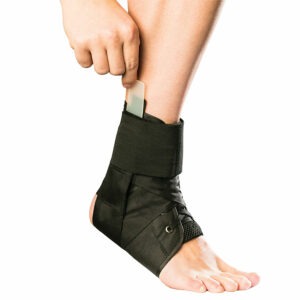Talus Stress Fracture
Updated:
(Also known as Talar Stress Fracture, Stress Fracture of the Talus)
What is a talus stress fracture?
The talus is a small bone of the ankle responsible for transferring weight bearing forces from the shin to the foot (figure 1). The talus is situated below the tibia and fibula (lower leg bones) and connects with these bones to form the ankle joint (figure 1). The talus bone also forms joints with several other small bones of the foot including the navicular and calcaneus (figure 2).
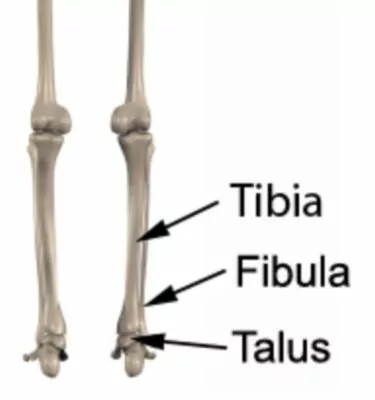
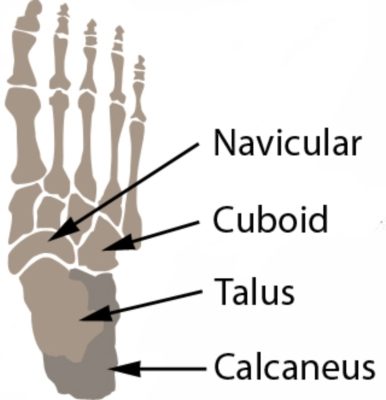
During weight bearing activity compressive forces are placed through the talus. When these forces are excessive, too repetitive and beyond what the bone can withstand, bony damage gradually occurs. This initially results in a bony stress reaction, however, with continued damage may progress to a talus stress fracture.
Cause of a talus stress fracture
Stress fractures of the talus typically occur gradually over time with excessive weight bearing activity such as running. They usually occur following a recent increase in activity or change in training conditions. They commonly present in athletes involved in running sports such as football and athletics.
Signs and symptoms of a talus stress fracture
Patients with this condition typically experience a deep ankle pain that increases with weight bearing activity. In severe cases, walking may be enough to aggravate symptoms. Other symptoms may include night ache, pain during certain movements of the foot and ankle or pain on firmly touching the talus.
Diagnosis of a talus stress fracture
A thorough subjective and objective examination from a physiotherapist may be sufficient to diagnose a talus stress fracture. Investigations such as an MRI, CT scan or bone scan are usually required to confirm diagnosis.
Treatment for a talus stress fracture
Most patients with this condition heal well with appropriate management. Treatment typically involves an initial period of rest from weight bearing activity which usually requires the use of crutches or a protective boot. In patients with a confirmed fracture, treatment may sometimes require 6 weeks plaster cast immobilization but this will vary from case to case.
Once the patient is out of the cast (or for those patients who do not require plaster cast immobilization), a gradual increase in weight bearing activity can begin provided there is no increase in pain. This should occur over weeks to months with direction from the treating physiotherapist or specialist and will vary depending on the severity of injury. Alternative exercises placing minimal weight bearing forces through the affected bones should be performed to maintain fitness such as swimming, cycling, and water running. Exercises to maintain flexibility, strength and balance are also important to ensure the ankle is functioning correctly. The treating physiotherapist can advise which exercises are most appropriate and when they should be commenced.
Contributing factors to the development of a talus stress fracture
There are several factors that may contribute to the development of a talus stress fracture. These should be assessed and where possible corrected with direction from the treating physiotherapist and may include:
- poor foot biomechanics
- inappropriate or excessive training
- inappropriate footwear
- joint stiffness
- poor flexibility
- muscle weakness
Physiotherapy for a talus stress fracture
Physiotherapy treatment is essential for all patients with this condition to hasten healing, prevent recurrence and ensure an optimal outcome. This may comprise:
- soft tissue massage
- joint mobilization
- electrotherapy (e.g. ultrasound)
- bracing or taping
- the use of crutches
- hydrotherapy
- biomechanical correction
- exercises to improve strength, balance and flexibility
- a gradual return to activity program
Other intervention for a talus stress fracture
Despite appropriate physiotherapy management, some patients with this condition do not improve and may require other intervention to ensure an optimal outcome. The treating physiotherapist or doctor can advise on the best course of management when this is the case. This may include further investigations such as X-rays, CT scan, MRI or bone scan, extended periods of plaster cast immoblization, review with a podiatrist for possible orthotics or referral to appropriate medical authorities who can advise on any intervention that may be appropriate to improve the talus stress fracture. Occasionally, patients with this condition may require surgery to stabilize the stress fracture and aid healing.
Exercises for a talus stress fracture
The following exercises are commonly prescribed to patients with a talus stress fracture. You should discuss the suitability of these exercises with your physiotherapist prior to beginning them. Generally, they should be performed 3 times daily and only provided they do not cause or increase symptoms.
Foot and Ankle Up and Down
Move your foot and ankle up and down as far as possible and comfortable without pain (figure 3). Repeat 10 – 20 times provided there is no increase in symptoms.
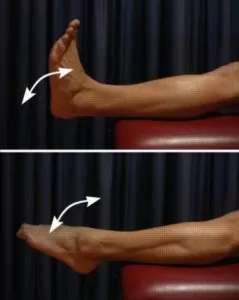
Foot and Ankle In and Out
Move your foot and ankle in and out as far as possible and comfortable without pain (figure 4). Repeat 10 – 20 times provided there is no increase in symptoms.
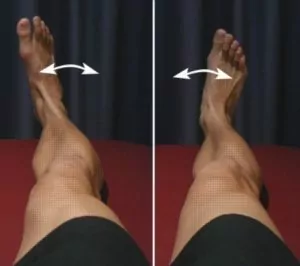
Foot and Ankle Circles
Move your foot and ankle in a circle as large as possible and comfortable without pain (figure 5). Repeat 10 times in each direction provided there is no increase in symptoms.
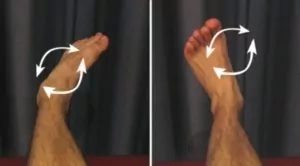
Physiotherapy products for a talus stress fracture
Some of the most commonly recommended products by physiotherapist to hasten healing and speed recovery in patients with a talus stress fracture include:
To purchase physiotherapy products for a talus stress fracture click on one of the above links or visit the PhysioAdvisor Shop.
More information
- View more Ankle Stretches.
- View Ankle Strengthening Exercises.
- View Balance Exercises.
- View Ankle Taping Techniques.
Find a Physio for a talus stress fracture
Find a Physiotherapist in your local area who can treat a talus stress fracture.

Link to this Page
If you would like to link to this article on your website, simply copy the code below and add it to your page:
<a href="https://physioadvisor.com.au/injuries/ankle/talus-stress-fracture”>Talus Stress Fracture – PhysioAdvisor.com</a><br/>PhysioAdvisor offers detailed physiotherapy information on a Talus Stress Fracture including: symptoms, causes, diagnosis, treatment, exercises, physiotherapy products and more...
Return to the top of Talus Stress Fracture.

